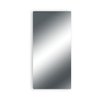Lava® Mirror 500W - 35″ X 25″ - Refurbished
- 120 volts, 500 watts, 4.17 Amps
LAVA® Radiant Panels Mirror Description
Envision radiant comfort with aLAVA ® Mirror Radiant Heating Panel. These 35” X 25” reflective heating panelsproduce 500 W to offer style, warmth, and a fog-free view when you step outof the shower. Install an optional towel bar and the 110V LAVA® Mirror can keepyour towels cozy and warm too. These C-UL-US Listed panels include a 5-yearwarranty and can are easily installed either horizontally or vertically.
Specifications
Electrical
| Amps | 4.17 A |
| Connection Method | Hardwired |
| Ohms | 28.78 Ω |
| Thermal Power | 0.5 kW |
| Voltage | 120 V |
| Watts | 500 W |
Performance
| BTU Per Hour | 1706 Btu |
| Maximum Surface Temperature | 203 °F |
Appearance
| Finish | Mirror |
| Version | Lava® Mirror - 35″ X 25″ |
Product Dimensions
| Installed Depth | 2.5″ |
| Length | 2′ 11″ |
| Size (Overall) | 35" x 25" (500W, 4.2A) |
| Weight | 48.1 lbs |
| Width | 2′ 1″ |
Identifiers
| Model | Mirror |
| SKU | IP-0500-LV-MIR-BTK |
| UPC (GTIN-12) | 881308073350 |
Documents & Manuals
Customer Questions & Answers
Infrared Radiant Heating Panels has 25 Questions and Answers.
How far from the radiant panel will the heat substantially radiate and where should it be aimed?
Radiant heat travels through air, and typically heats up objects closer to the panel first and then the rest of the room later. Infrared heating from the panel can be easily detected from about 3-4 feet. Ideally, the radiant panel should be aimed onto the area with more use, since that will be the surface that will warm up first.
23 people found this helpful. Did you find this helpful? Yes NoHow do you keep a sunroom warm in the winter?
Sunrooms can be very cold during the winter months. While a furnace may push some warm air into the room, the large number of windows, exterior walls, and other causes of heat loss in a sunroom will typically keep it from having a comfortable temperature level. Floor heating and radiant panels will add radiant heat, which the human body absorbs faster than other forms of heat, to the room so that it feels warm even at lower temperatures.
17 people found this helpful. Did you find this helpful? Yes NoHow far from the radiant panel will the heat substantially radiate and where should it be aimed?
Radiant heat travels through air, and typically heats up objects closer to the panel first and then the rest of the room later. Infrared heating from the panel can be easily detected from about 3-4 feet. Ideally, the radiant panel should be aimed onto the area with more use, since that will be the surface that will warm up first.
8 people found this helpful. Did you find this helpful? Yes NoHow does one know which size panel is correct for a room?
Is there a concern with children touching the radiant panels if they get too hot?
View all 25 Questions and Answers







